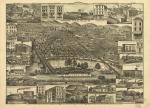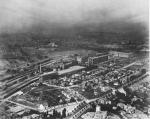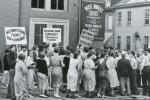![header=[Marker Text] body=[Laid out 1748 by direction of Thomas Penn. Seat of Berks County since 1752. Incorporated borough, 1783. Soon became, and has remained, center of the Pennsylvania-Dutch area. An old and progressive industrial community.] sign](http://explorepahistory.com/kora/files/1/10/1-A-245-139-ExplorePAHistory-a0m9i2-a_450.gif)
Mouse over for marker text
Name:
Reading [Labor]
Region:
Hershey/Gettysburg/Dutch Country Region
County:
Berks
Marker Location:
U.S. 222; U.S. 12
Behind the Marker
Describing the crowds that flocked to hosiery counters after the end of World War II, Wyomissing Industry's Yarn Carrier recounted, "This was an army of women determined to march on lovely legs." Once wartime production restrictions were lifted, Reading's hosiery manufacturers quickly returned to the production of the nylon stockings for which they were known.
Formerly celebrated as the home of the Reading Railroad, Reading was now promoted by its manufacturers as "The Nation's Full-Fashioned Hosiery Center." Established manufacturers, however, soon faced over-production as small operators entered the business. By 1947, there were seventy-seven full-fashioned plants, up from forty-seven in 1940.
Following several relatively successful years, Reading's full-fashioned hosiery industry collapsed. Like other Pennsylvania producers, Reading's manufacturers succumbed to increasing competition from seamless hosiery plants in the southern United States and overseas. Based in neighboring Wyomissing, Berkshire, the world's largest full-fashioned hosiery mill, began to establish operations overseas in 1948, and in 1951 opened a branch in North Carolina.
In 1952, the Rosedale Knitting Mill in neighboring Laureldale shut for good during a Hosiery Workers Union strike, and Nolde and Horst sold its Reading plant to a Canadian producer. By the late 1950s, a variety of producers leased the space to produce apparel for outlet sales. Reading's Oakbrook Hosiery Mill managed to hang on until the later 1950s before closing as well. Most of the smaller plants failed too, although a few survived into the 1950s by producing cotton, wool, and mixed seamless hosiery. In 1955, Berkshire added a seamless department but could not compete with the southern plants and sold its plant to the Vanity Fair Corporation in 1969. A few years later, much of its production space was converted to outlet sales.
As the hosiery mills closed, other manufacturers took the lead in employment. With help from the Greater Berks Development Fund, Western Electric leased part of Rosedale Knitting Mill complex in 1952 and retrained unemployed hosiery workers. Encouraged by their success, they opened a new plant just north of Reading in 1959 and soon became the county's leading employer. Seeking to diversify, Wyomissing's Textile Machine Works purchased New Hampshire's Arrow Needle Company, which it later moved to Reading, where it produced surgical instruments.
After unsuccessfully trying to enter the circular knitting machine market in the 1950s, Textile sold its plant in 1968 to Rockwell International, which continued production of full-fashioned machines before switching to printing presses in the mid-1970s. Although Carpenter Steel did manage to survive as Carpenter Technology, deindustrialization took a toll on the remaining heavy industry in Reading, forcing many to commute outside the county for work.
Under the leadership of Kitty Solomon, the Berks County Pennsylvania Dutch Travel Association turned to tourism to increase area earnings. Arguing that outlet shopping could be a major attraction, she convinced the V.F. Outlet, Great Factory Store, Talbots, and David Crystal to join the association, and helped establish itineraries for tour brokers to stop at the outlets. The association made reservations for meals and lodging and provided tour guides for the visiting buses. Soon Reading's success as "The Outlet Capital of the World" attracted national interest and prompted other towns to try the same.
In addition to its economic challenges, Reading, like cities across the Commonwealth, also faced the challenges created by suburban sprawl. The flight of whites from the city left African Americans and a growing Hispanic community downtown, where businesses struggled to compete with suburban malls and entertainment options, including the Reading Drive-in and the Spring Drive-In, which in 1955 claimed the largest screen in the world.
In 1950, Reading, with 110,00 residents, accounted for half the jobs in Berks County. By 1970, its population had declined by around 30,000. Despite the strains of suburbanization, Reading remained relatively peaceful during the turbulent 1960s, until March 1969, when a group of white high-school students threatening the House of Soul, a gathering place for young blacks supported by anti-poverty funds, sparked a "race riot" after police arrested some young blacks instead of young whites.
Like Lancaster, Reading also suffered from floundering urban renewal plans, as parking lots replaced demolished buildings, which caused local poet Byron Vazakas to describe the downtown as "Rue of Ruins." To compete with the new Berkshire Mall in Wyomissing, the Redevelopment Authority promoted its Downtown East project with an enclosed mall to be anchored by Pomeroy's department store. After they cleared the land, however, plans fell through, and the area served as a pedestrian mall for a decade. By the late 1970s, planners were again reassessing the city's future, and attempting to save historic buildings that had survived the wreckage of renewal.
Still struggling with poverty and crime, Reading has promoted renovation and festivals to renew city life. In September 2001, a new civic center opened, including a renovated Rajah Theatre and the Sovereign Center arena. (It occupied the area cleared by the Model Cities program but also removed, over protests, the remaining Astor Theater.) Opened four years later with the help of Albert Boscov, the GoggleWorks Center for the Arts provided a focus near the riverfront and renewed hopes for Reading's revival.
Formerly celebrated as the home of the Reading Railroad, Reading was now promoted by its manufacturers as "The Nation's Full-Fashioned Hosiery Center." Established manufacturers, however, soon faced over-production as small operators entered the business. By 1947, there were seventy-seven full-fashioned plants, up from forty-seven in 1940.
Following several relatively successful years, Reading's full-fashioned hosiery industry collapsed. Like other Pennsylvania producers, Reading's manufacturers succumbed to increasing competition from seamless hosiery plants in the southern United States and overseas. Based in neighboring Wyomissing, Berkshire, the world's largest full-fashioned hosiery mill, began to establish operations overseas in 1948, and in 1951 opened a branch in North Carolina.
In 1952, the Rosedale Knitting Mill in neighboring Laureldale shut for good during a Hosiery Workers Union strike, and Nolde and Horst sold its Reading plant to a Canadian producer. By the late 1950s, a variety of producers leased the space to produce apparel for outlet sales. Reading's Oakbrook Hosiery Mill managed to hang on until the later 1950s before closing as well. Most of the smaller plants failed too, although a few survived into the 1950s by producing cotton, wool, and mixed seamless hosiery. In 1955, Berkshire added a seamless department but could not compete with the southern plants and sold its plant to the Vanity Fair Corporation in 1969. A few years later, much of its production space was converted to outlet sales.
As the hosiery mills closed, other manufacturers took the lead in employment. With help from the Greater Berks Development Fund, Western Electric leased part of Rosedale Knitting Mill complex in 1952 and retrained unemployed hosiery workers. Encouraged by their success, they opened a new plant just north of Reading in 1959 and soon became the county's leading employer. Seeking to diversify, Wyomissing's Textile Machine Works purchased New Hampshire's Arrow Needle Company, which it later moved to Reading, where it produced surgical instruments.
After unsuccessfully trying to enter the circular knitting machine market in the 1950s, Textile sold its plant in 1968 to Rockwell International, which continued production of full-fashioned machines before switching to printing presses in the mid-1970s. Although Carpenter Steel did manage to survive as Carpenter Technology, deindustrialization took a toll on the remaining heavy industry in Reading, forcing many to commute outside the county for work.
Under the leadership of Kitty Solomon, the Berks County Pennsylvania Dutch Travel Association turned to tourism to increase area earnings. Arguing that outlet shopping could be a major attraction, she convinced the V.F. Outlet, Great Factory Store, Talbots, and David Crystal to join the association, and helped establish itineraries for tour brokers to stop at the outlets. The association made reservations for meals and lodging and provided tour guides for the visiting buses. Soon Reading's success as "The Outlet Capital of the World" attracted national interest and prompted other towns to try the same.
In addition to its economic challenges, Reading, like cities across the Commonwealth, also faced the challenges created by suburban sprawl. The flight of whites from the city left African Americans and a growing Hispanic community downtown, where businesses struggled to compete with suburban malls and entertainment options, including the Reading Drive-in and the Spring Drive-In, which in 1955 claimed the largest screen in the world.
In 1950, Reading, with 110,00 residents, accounted for half the jobs in Berks County. By 1970, its population had declined by around 30,000. Despite the strains of suburbanization, Reading remained relatively peaceful during the turbulent 1960s, until March 1969, when a group of white high-school students threatening the House of Soul, a gathering place for young blacks supported by anti-poverty funds, sparked a "race riot" after police arrested some young blacks instead of young whites.
Like Lancaster, Reading also suffered from floundering urban renewal plans, as parking lots replaced demolished buildings, which caused local poet Byron Vazakas to describe the downtown as "Rue of Ruins." To compete with the new Berkshire Mall in Wyomissing, the Redevelopment Authority promoted its Downtown East project with an enclosed mall to be anchored by Pomeroy's department store. After they cleared the land, however, plans fell through, and the area served as a pedestrian mall for a decade. By the late 1970s, planners were again reassessing the city's future, and attempting to save historic buildings that had survived the wreckage of renewal.
Still struggling with poverty and crime, Reading has promoted renovation and festivals to renew city life. In September 2001, a new civic center opened, including a renovated Rajah Theatre and the Sovereign Center arena. (It occupied the area cleared by the Model Cities program but also removed, over protests, the remaining Astor Theater.) Opened four years later with the help of Albert Boscov, the GoggleWorks Center for the Arts provided a focus near the riverfront and renewed hopes for Reading's revival.







